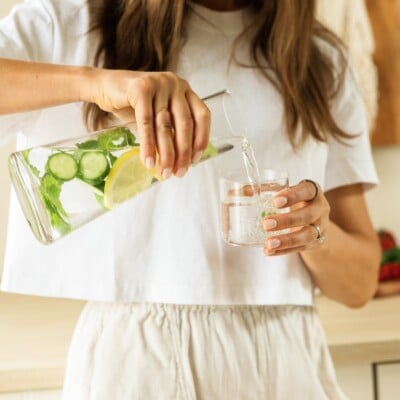As a cyclist who used to ride 50-100 miles every weekend, I know first-hand that how you fuel on and off the bike is key to performance and recovery. However, in the past year, I’ve swapped those weekend rides for lots of travel, filled with important meetings, speaking opportunities, and shorter workouts. I’m busier than ever and my body often times feels more drained than it did after a 50-mile ride. While I try to fuel properly and my keep brain function in tip-top shape (hello MCT oil), I can always do better. So, I tapped former pro-athlete and present-day chef and cyclist Lentine Alexis to help guide us on how we should approach food for performance. Lentine and I met through our ambassadorship with Rapha, and her easy and accessible approach to food has always appealed to me — plus, she posts the most gorgeous photos on Instagram. Every morning, with my coffee in hand, I watch her stories to see what she’s cooking up, which usually inspires a breakfast or dinner during the week. Her Super Simple Sesame Onigiri continues to be a favorite.

To kick things off, what is your approach to food?
I eat it all, in moderation of course. I consider myself to a ‘selectarian.’ I eat anything and everything, but insist that I know where it comes from and how it’s produced – that means organic vegetables, humanely raised grass-fed meats (typically I know the farmer and where they raised the animals, too), and local ingredients whenever I can find them. With that, I aim to make the simplest, most delicious, and straightforward meals I can. My mother is celiac, and while I don’t have inconsistencies, I really try to eat a variety of grains, protein sources and colorful ingredients. I believe in listening to our bodies and consciousness when it comes to food and eating – our bodies will tell us what they want and need, or don’t want and don’t need. It’s our job to LISTEN.
I hear you there. Over the years, I’ve come to learn how smart our bodies are and when I listen to what I really need, I really feel better.
Switching gears (no pun intended), as a cyclist who has trained for half marathons in the past, I’ve had a hard time stomaching packaged energizing foods, but I wasn’t well-versed on how to replenish my body or fuel naturally. What are your go-to’s for fueling and why?
First, so many athletes struggle with this and most of the reason is that there are so many ingredients in packaged “energy foods,” that our bodies don’t recognize and can’t use them for anything, much less for athletic fuel. That said, my go-to athletic fuel is always pretty simple; our bodies need carbohydrates to fuel activity, so that’s what I put in. Fat and protein help those carbohydrates to burn a bit slower so that’s good too. My favorites are bananas, almond butter, maple syrup packets, homemade raw date + coconut bars, and chocolate chip cookies. Long bike rides are really the only places I CRAVE great chocolate chip cookies!
Agreed, the harder I work out, the more I crave some sweet with a smidge of salt, so I’d top my cookie off with a pinch of Maldon salt. Lentine got me hooked on buying these travel salts for post-workout or a snack at my desk.

What’s more important, pre-workout or post-recovery fuel?
The broad answer is that the nutrition you put in before and after your workout are equally important. When I coach athletes on their eating and nutrition habits, I encourage them to look at the foods they eat each day like a checklist. It’s true that your body will ask for certain nutrients at certain times, depending on your activity, but for most of us who are doing just a moderate level of activity each day, for a moderate amount of time (say, a spin class) having a balanced diet all day is more important than pre or post workout fuel. That said, when you eat is pretty important. Waking up, going to workout and not having a snack ahead of time can make lots of athletes feel sick, sluggish or out of energy. Likewise, not eating a little snack within an hour after a challenging run could run your tank to empty and lead you to feel out of control hungry later. My suggestion is to think about your daily nutrition as one big food checklist, and then try to fit in all the bits and pieces within your schedule, aiming to give yourself 1.5 hours of digestion time after a meal and before exercise. For me, this looks like coffee and a banana with almond butter before a morning workout, and then granola and kefir with green juice after. For an afternoon workout or evening workout, I’ll make sure to eat a light lunch at a reasonable hour, have a homemade date bar or eat that banana mid-afternoon, then try to time my dinner within an hour after my workout.
While some of us aren’t athletes, we are busy entrepreneurs, running large companies, or running a family, and our productivity is key. What foods will help us with that?
As it turns out, the foods that athletes need aren’t any different than the foods that active, professional crushers need. All of us are busy, on the go constantly, using our brains and bodies to make.shit.happen. It’s just that the athletes likely get their heart rates a little higher! All of us need clean, simple, vibrant, colorful and super-nutritious food to help us feel our best. This means lots of fruits and vegetables, healthy complete proteins that build bones, muscles and brains, clean-burning carbohydrates, healthy fats, and all in little delicious packages that sate our emotions and make us feel that we’re honoring our bodies. Those are the foods that make us all perform at our best.
Do you believe we should structure our meals? Meaning: 50% protein, 30% fat, 20% carbohydrates?
If you’re an elite athlete with a very specific anticipated emotional and physical output of energy each day, then it’s important to be highly structured with your nutritional intake. Otherwise, I find that it’s really just important to try to check the blocks in our heads mentally — make sure to get some protein, fat, carbohydrates and fresh vegetables at each meal. If you feel later that you’re still craving something, have a snack that fills the gap. For example, I just was at an airport after running around all day, nibbling but not eating complete meals. I felt unsatisfied, but also a bit sluggish, I know that something sweet would burn right through my system, but that something light with some carbohydrates, some fat, and lots of protein would pull me back from my hectic day. I had a nice kale salad with roasted vegetables, grilled chicken, quinoa and a good sprinkling of flaky sea salt for dinner and now my brain is sharp enough to tap out these questions, and my belly is satisfied. Learn to listen to what your body truly, completely and absolutely is asking for – maybe salt? Protein? A sweet treat? Don’t put anything in until you figure it out. Then, answer that calling. This will always work better than a prescribed ratio in my experience.

How should we think about food as it relates to performance?
Without clean fuel, your car doesn’t run. Without clean, healthy food that provides the ingredients our bodies need to be our best, we won’t run, whether we’re athletes or not. We’re only as good as the food we put in, which is really something to think about when we go out to “celebrate,” and completely lose control, eat all the queso or chocolate cake before that big meeting or big event in the morning. If we aren’t feeding our bodies real food, we really won’t perform. If we aren’t proud of what we put in, we won’t be proud of what we put out.
I fully believe and live that. While I try to eat as clean as possible, it’s a guarantee that one to two days before any big meeting, public speaking opportunity, event, travel, etc., I only eat clean and end up feeling fantastic.
What’s one ingredient you’re really into right now for performance either on or off the bike?
I’ve been using ashwaghanda and chlorphyll religiously and really enjoy it. I’m absolutely fascinated with adaptogens and supporting a healthy microbiome, and have found lots of power in using these ingredients for sports performance as well. Ashwaganda, Reishi, Chaga and Cacao are favorites — I’ve been making a recovery hot chocolate with the four combined in almond or cashew milk all winter long! I also stir them into tea if I’m working in the kitchen mid-day, and mix them into little energy balls I make with coconut butter (also a massive favorite ingredient) and I find that it’s a delicious fat source that burns clean and can be made savory or sweet no matter what I’m eating. I’m drooling just thinking about it.
Ok so we know your affinity for real and wholesome foods, but what do you splurge on? Where do you bend the rules?
This question is making me smile because I don’t think my definition of a “splurge” is what most folks think of as splurging. I think of a splurge as something I’m deeply grateful for, something that’s satisfying in the sense that I truly treated myself, and devouring a whole sleeve of Oreos would never be that for me. But every once in a while, I buy a bag of tortilla chips and make nachos for dinner. Typically they’re pretty virtuous and almost always organic. I have an exceptional collection of special chocolate bars and I nibble a piece of chocolate every day. I was in Marfa a few months ago, we’d just finished a bike ride and came upon a Dairy Queen and suddenly a dipped cone was the most logical thing in the world. It was DELICIOUS. But I don’t look at these as “splurges,” they’re just the answers for whatever I’m craving emotionally or physically. I really try to ignore the “food rules” that society implies – I don’t believe that there are bad foods or naughty foods, but I do believe in bad food habits. I like to think that by practicing good food habits, I’m indulging in the biggest, most worthy splurge of all.
Thanks for your nuggets of wisdom, Lentine!





